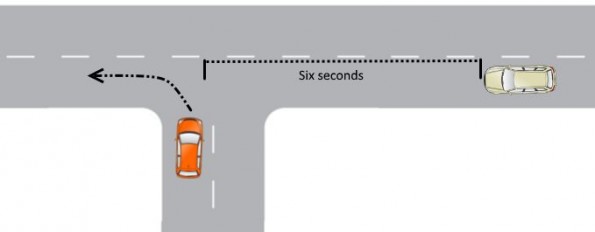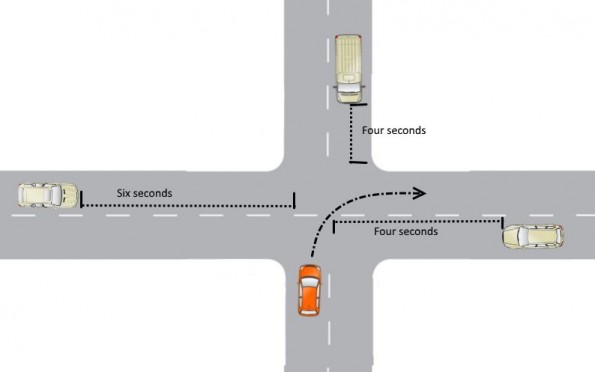Whenever you perform a manoeuvre such as turning right or left at an intersection, doing a u-turn, changing lanes, overtaking another vehicle or opening your vehicle’s door when there’s traffic passing, you make a gap selection (also called ’emerging’ if you passed your test in the UK). Safe gap selection makes sure that you don’t cause another road user to take evasive action, crash into you (or something else) or have to brake.
Inexperienced drivers can sometimes struggle with gap selection because the only thing that improves it is practice. Around one third of accidents involving provisional drivers are caused by unsafe gap selection. As gaps must be selected on all kinds of roads at all kinds of speeds, the results can be anything from a minor fender-bender through to multiple fatalities (especially if a truck is involved).
What is an unsafe gap?
Unsafe gaps are those where if you made your manoeuvre you would disrupt the flow of traffic. Other vehicles will have to brake to avoid a collision.
You don’t have to take a gap that is unsafe; it’s perfectly fine to wait for a safe gap, so don’t feel pressured to go.
How can you improve the safety of your gap selection?
Turning from or into an intersection
- Accelerate briskly: if you dawdle then you increase the time you need to cross the lanes and get up to speed, but don’t accelerate so fast that you risk wheelspin or loss of control
- Use median strips to help you: you can pull across into the median strip so that you’re out of the main traffic flow
- Know how fast your vehicle accelerates: some vehicles aren’t very quick off the line, and if your exit is uphill then you will take longer to accelerate
- Know how long your vehicle is: if you have a longer vehicle or you’re towing a trailer you will need more time to cross the intersection (and a trailer also adds weight which slows your acceleration)
- Know the weather conditions and how much grip you have: wet roads have less grip and therefore you are more likely to wheelspin coming out of an intersection, and you won’t be able to accelerate as fast as on a dry road
- Check that where you are going is not blocked by pedestrians or other vehicles
- Check for manhole covers that might be more slippery
Overtaking
- Check there’s a gap in front of the vehicle you are overtaking that you can pull back into
- Check that you will be able to see at least 100m of clear road ahead of you for the whole time while you are overtaking
- Read our guide to overtaking for more tips.
Merging and changing lanes
- Know the length of your vehicle – longer vehicles need a longer gap
- When choosing a gap to merge onto the motorway, get your vehicle up to the same speed as the vehicles already on the motorway
- Clearly signal your intentions for at least three seconds to allow other drivers to see what you want to do. They might create the safe gap for you, but if not, you will still need to wait for a safe gap
- Don’t judge traffic’s speed and position just by using your mirrors
- When using the hard shoulder after, for example, repairing a tyre, get up to speed on the hard shoulder before merging back into the left-hand lane of the motorway.
What factors make gap selection more difficult?
Shadows, low light and darkness
Smaller road users like motorbikes and cyclists are much less visible in lower light. Plus, they only tend to have one source of light and that makes it more difficult to judge their distance and approach speed.
Emerging from an intersection where there’s a lot of dappled light can make it difficult to judge distances.
Sun dazzle or sun strike reduces your visibility of everything as you’re looking directly at the sun.
Intersections with good visibility and give way signs
When you approach an intersection with good visibility each way it is likely to have give way signs and this means that you don’t (by law) have to stop if the way is clear for you to turn out of the intersection. However, judging the distance of approaching vehicles is more difficult when you are moving as you have to be looking where you are going, and your position relative to approaching vehicles is changing slightly.
If you can remain moving at these intersections then it can give you an advantage in terms of using some of your residual speed to help you get across the intersection.
Intersections with gradients
If your exit road is uphill then it will take longer for you to accelerate and there’s more chance of wheelspin as you turn and the inside wheel is unloaded slightly.
Velocity transposition and the illusion of velocity and size
Large objects appear to be moving more slowly than smaller objects. This is called velocity transposition and is part of the illusion of velocity and size. You could test this with a radio controlled car versus a real car. If both vehicles are doing 40kph then the real car will look like it’s going very slow compared to the radio controlled car. Part of this is related to how quickly the vehicle moves through its entire length. A 53.5-metre road train travelling at 80kph takes 2.4 seconds to travel its own length, compared to 0.2 seconds for a modern hatchback.
What this means is that when a large truck approaches you, it looks like it’s going slower than it actually is, and that increases the risk that you will pull out in front of it.
Selecting safe gaps
Turning left from a T-intersection

Left turns are less complex than right turns. You don’t have to consider the approach speed of traffic from the left, although you do still need to check the traffic from the left before emerging from the intersection in case someone is overtaking, pedestrians are crossing, or if the way isn’t clear (e.g. backed up traffic). However, the turn itself will be sharper which means you can’t accelerate out of the intersection as quickly.
Regardless of what speed other traffic is approaching, you need to give yourself a six second gap. If the road is dry and you are in a powerful car, then slightly less could be OK, but if the road is wet and you’re in a slower car or you’re towing a trailer, you could need more gap. Six seconds at 60kph is about 100 metres.
Turning right from a T-intersection

Your advantage when turning right is that it’s a much shallower turn and that means you can accelerate more quickly to get across the lane. You’ll need to leave four seconds’ gap for traffic coming from your right and (as with the left turn) six seconds gap for traffic that is in the lane you’re turning into (i.e. from the left this time).
If there’s a median strip you can use that to wait for a safe time to merge into traffic coming from the left.
You can adjust how shallow you make your right turn based on how close vehicles from the right are. If the gaps are smaller, make a more direct route across the road.
Turning right into a side street
It’s more likely that you will be able to maintain some speed and not have to stop before turning right. However, if you do have to stop, it will take you three to four seconds to get across the other lane. Make sure that there’s nothing blocking your way in the street you’re turning into.
Crossing crossroads
If you are going straight over the crossroads then you will need around four seconds to your left and three seconds to your right. Any vehicles coming towards you will need to give way to you so they are of no concern. If you are crossing a dual carriageway then you will need more time.
Turning right at crossroads

As when turning right at a T-intersection, you’ll need four seconds to your right and six to your left. However, if there are vehicles coming towards you that are turning left or crossing the crossroads you must give way to them, too. You will need to allow at least four seconds gap for them as it will take you at least two or three seconds to get across to the other side of the road.
Making a u-turn
The safest way to perform a u-turn is to pull over to the left so that you have a greater width of road to complete the manoeuvre. You will have to judge the distance of drivers approaching from behind as well as ahead of you. You can’t judge this using your mirrors – you must turn your head. Is your vehicle able to make the u-turn in one go? The turning circle of some vehicles might not be tight enough to do it, in which case you’ll end up doing a three-point turn.
A safer option on a busy street is to turn into a quieter road on the right or left, do a three-point turn (preferably in a driveway to be extra safe), then get back onto the main road.
Overtaking or passing
You can read our overtaking guide for more information, but (in brief) you need to:
- Judge the speed of approaching vehicles
- Ensure that there’s a gap ahead of the vehicle you are overtaking
- Ensure that a vehicle behind you hasn’t started to overtake
- Check that you will be able to see at least 100 metres of clear road ahead of you for the whole time you’re overtaking.
In busy traffic
In rush hour you might be relying on courteous drivers to let you into the traffic stream. If turning left, make eye contact with the driver. They might have flashed their lights or waved you into the traffic. This kind of scenario is dangerous for cyclists travelling down the left faster than the main traffic flow.
If you are turning right out of the intersection and there’s a gap in stationary traffic (or very slow-moving traffic), there will be a huge blind spot behind the line of vehicles as you emerge from the intersection so take care.
Improving your gap selection skills
Practice is the only way you can improve your gap selection skills. Just like our ability to catch a ball, our brains can calculate how fast an object is approaching and what trajectory it’s taking. But it takes time to hone this skill. You can go out and observe other drivers at intersections and get an idea of how they choose gaps. Then sit with another experienced driver and watch them choose gaps. Then have a go yourself with an experience supervisor or driving instructor. The more you do it, the better you will become.
